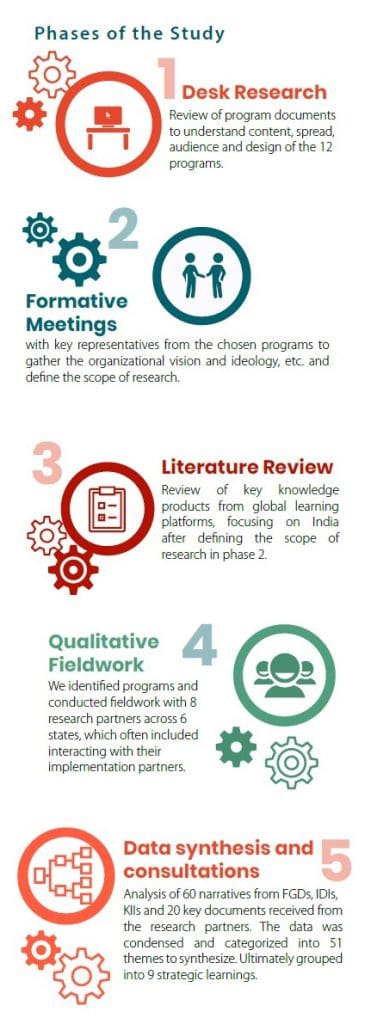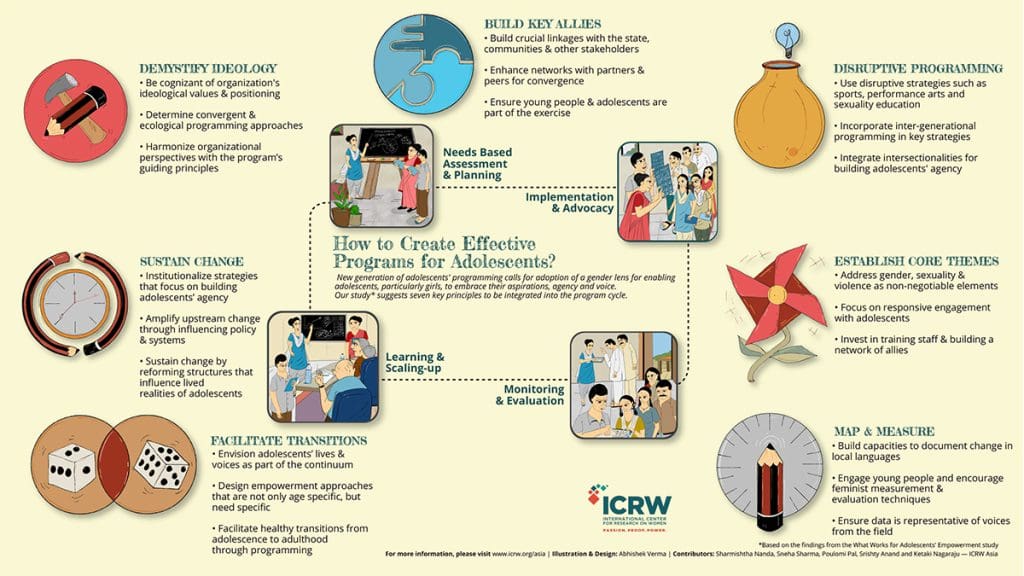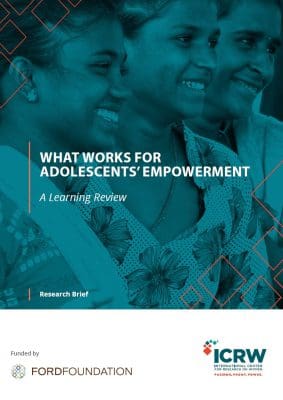
What Works for Adolescents’ Empowerment
Adolescents and Youth, Men and Masculinities, Sports for Development, Violence Against Women and Girls
2020
Adolescence marks the developmental transition from childhood to adulthood; a time when many important social, economic, biological, and demographic events set the stage for adult life. The nature and quality of young people’s future, as well as a country’s future social and economic development, depends largely on how well adolescents navigate this transition. Programming for adolescent girls and women has increasingly focused on empowerment approaches. In this context, empowerment is seen both as a process and an outcome.
As part of a research project—Vikalp: Learning Review on What Works for Adolescents’ Empowerment, funded by the Ford Foundation—these publications and film highlight learnings from current strategies to create and sustain empowering spaces for adolescent girls.
Explore the Publications
 WHAT DID WE SET OUT TO DO?
WHAT DID WE SET OUT TO DO?
ICRW, with support from the Ford Foundation, undertook a learning review focusing on two thematic areas of programming for adolescent girls with the following objectives:
- To understand the drivers and pathways to solutions adopted for issues identified by the specific projects included in the review
- To understand the organizational ideologies and how these influence organizations adopting certain program strategies
- To explore what remains to be done in the context of creating empowering spaces and identify strategies for sustaining these spaces
12 projects were reviewed across six states in India to explore how certain approaches produce solutions and pathways relevant to their thematic focus. The key learning emphasizes how strategies around programming for adolescents have been previously documented and evaluated, but often do not reflect the influences of organizational ideologies on the resultant pathways and, ultimately, the outcome.
KEY FINDINGS:
Synthesized findings from individual projects and their contexts resulted in a cumulative understanding of strategic learnings highlighted below:
- Organizational vision, ideologies, values, and perspectives ultimately denote a set of norms and shared understanding that guide the decisions of the organization. These parameters also influence program strategies in the context of adolescent empowerment.
- Data collection processes should be ground up, participatory approaches to capture the complex construct of empowerment and its inherent components. These processes need much work to be truly representative of and meaningful to the people part of the programs.
- The need to engage with key influencers in the ecosystem of adolescents has been greatly emphasized. Along with this, convergent approaches are required for pooling in resources, departments and program strategies to amplify efforts directed toward an issue.
- Men and boys often act as key decision-makers in girls’ lives. Effective engagement with men and boys provides spaces for them to critically reflect on harmful gender norms. This enhances opportunities for men and boys to be active contributors for creating an enabling ecosystem for girls.
- The success of safe spaces is dependent on staff who directly engage with adolescents in creating and sustaining them. Hence, investing in their skills, perspectives and motivation is crucial.
- There is an increasing awareness of engaging on issues of choice, voice and agency, which is critical for navigating sensitive domains such as choice of education, livelihood, experiences of desire, and safe and consensual relationships. Programs that invest in developing capacities of young people as peer leaders create role models for adolescent girls and ensure a meaningful engagement.
- Sports promote multiple dimensions of agency building for girls in contexts with rigid gender norms. Sports is cited as a personally invigorating and empowering experience, which provides access to public spaces, physical training and builds abilities for better communication, negotiations and decision-making. Sports has proven to be effective in building confidence and promoting body positivity for young girls.
- Some of the aspirations consistently voiced by girls include: attaining higher education, receiving skill training, participating in formal work, having freedom of mobility in public spaces, and marrying by choice. Adolescent programs that encompass some of these into their design are able to connect better to the realities of girls’ lives.
- Fear of violence is immense for families, communities and girls at large, and often used as a tool to control and police girls to reinforce gender norms. Program designs constantly navigate this impending fear of violence and backlash. However, there is scope for engaging more deeply with the “everydayness” of violence in the lives of girls.
Read more about this project and what we learned by clicking on the links to read the brief or the full report.
RELATED CONTENT

The film below, Parwaaz, meaning ‘flight’, establishes the issue of adolescent empowerment as a multilayered concern. This film focuses on stories that highlight useful strategies for developing an enabling environment through the creation of safe spaces for girls.
Nanda, S., Sharma, S., Anand, S., Pal, P., Nandi, S. (2020). What Works for Adolescents’ Empowerment: A Learning Review. New Delhi: International Center for Research on Women.



